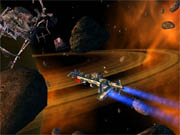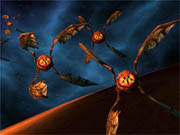Earth and Beyond Q&A
Earth and Beyond producer Eric Wang shares new details on Westwood's new massively multiplayer RPG, including information about the class system, general gameplay, and more.

To say that Westwood Studios is taking a step in a different direction may be a slight understatement. The company that has been known for producing some of the most popular real-time strategy games--such as the Dune series and Command and Conquer series--is moving into new territory with its upcoming massively multiplayer RPG, Earth and Beyond. Part of what separates Earth and Beyond from other games in the genre is the setting of deep space, where traditional avatars are replaced with starships and peaceful towns turn into spectacular space stations. Earth and Beyond's gameplay has been designed to take advantage of this unique setting, allowing you to choose one of any three major class options, which include warrior, explorer, and trader. These classes have unique traits that encourage cooperation in certain situations and generally make it much easier to level up as you progress through the game. We caught up with Eric Wang, producer of Earth and Beyond, to find out why the company wanted to develop a massively multiplayer game, how missions and other aspects of gameplay function, and what the difficulties of developing a game are within the massively multiplayer RPG genre.
GameSpot: Westwood has always had a reputation for making it easy for players to jump into a game. Is Earth and Beyond being designed to cater exclusively toward players who spend large amounts of time playing massively multiplayer role-playing games, or will casual players be able to enjoy the game as well?
Eric Wang: All of the above. Everyone will be able to have an entertaining experience in Earth and Beyond. We're designing a game that makes it very easy for anyone, even beginners, to jump right in and have an exciting and rewarding time right off the bat. We didn't want to create a game that's immediately frustrating to players, so we empower them from the moment they step into the game, giving them their own spaceship and making it easy for them to accomplish their goals and "level up." On the other hand, Earth and Beyond has a tremendous amount of depth that will make it continuously challenging for hard-core gamers and persistent world fans.
GS: What other sources served as the biggest inspiration for the developers? Will players be able to see a direct influence from any specific games, movies, or other media?
EW: The development team has drawn inspiration from games like Elite, Privateer, Tradewars 2000, Starflight, and Starfleet Battles. Elements of all of these games have definitely shaped the development of Earth and Beyond. We are also avid readers and moviegoers and have pulled ideas and inspiration from many different sources.
GS: What inspired Westwood to begin development on a massively multiplayer game?
EW: Brett Sperry, cofounder and chief creative officer of Westwood, came up with the original concept for Earth and Beyond. Brett had wanted to develop a game like this for a long time, and with the technological advancements and the prevalence of the Internet in our daily lives, we could finally build the game he had been envisioning. Brett has been very involved in the development of Earth and Beyond, so we have remained faithful to his original concept of limitless possibilities in an epic and ever-changing universe.
GS: How is Earth and Beyond going to compete with so many other online role-playing games coming out this year and next?
EW: The persistent-world genre is a very competitive category, but I'm actually really excited about that. The variety of persistent-world games being released in the coming years proves that the market for online games is growing.

That said, I really believe we're offering players something they won't find in any of the other persistent worlds. We empower players from the moment they step in the game by giving them their very own starship. From that point on, newbie and hard-core players alike will find elements of Earth and Beyond that are unique. We're creating an environment that encourages people to cooperate, rather than compete to achieve their goals, and we're acknowledging and rewarding all play styles, from combat to trade and exploration.
GS: Has there been any direct crossover between the development of Westwood's other games and Earth and Beyond? In other words, has Westwood learned anything in developing Earth and Beyond that has helped the developers make their other games, and vice versa?
EW: There is crossover between Earth and Beyond and Command & Conquer Renegade in the 3D engine. In addition to that, we have a wealth of information and assets available in our team members. We learn with every product Westwood develops, so there is always cross-pollination of design and technology in our titles.
GS: Earth and Beyond features three main character classes--the explorers, the traders, and the warriors. How is Westwood going to balance the game so that players will want to play all the different classes, rather than all the players migrating toward combat?
EW: We're taking balance a step further by designing the three character classes to be interdependent. Players will be able to reach the highest level of success in the game by partnering with other players. All three classes have their areas of expertise. For example, the tradesmen are capitalists. They will have the best negotiating skills and will also be able to manufacture rare and powerful items as well as repair ships during or after a battle. The explorers are the scientists of the game. They are the best at navigation, can cloak themselves and their teammates, as well as be able to identify targets at great distances. The warriors focus on combat. They have the best weapons and quickest response times.
GS: How much influence can individual players have on what goes on in the game? Will higher-level characters get additional political power?
EW: Earth and Beyond has been specifically designed to empower each and every player, right from the beginning of the game. Each player will also have opportunities to shape the universe as the game progresses, specifically through missions. There are two types of missions in Earth and Beyond: personalized missions designed for each individual player and crafted missions. The crafted missions serve to advance the overall story of the game, whether it's assassinating a key NPC [nonplayer character], organizing a raid on a space station, etc. It will be challenging for individual players to have a huge impact on the game, but by banding together, a group of players will definitely be able to affect the overall storyline.

In addition, players will be able to read about their and others' exploits in the game through the Galactic News Network. Logging on to this network, either in or out of the game, will give the player all kinds of information, such as the time and location of battles, discoveries of far-flung planets, and the current market price of valuable minerals. In addition, we plan on having live events on a constant basis. We will have a full-time staff that's dedicated to evolving the story of Earth and Beyond.
GS: What's been the toughest part of development so far? How was the team able to overcome the challenge?
EW: The toughest part of developing Earth and Beyond is designing and programming for the sheer scope of the project. This is Westwood's first venture into a persistent world, and we're dealing with new technologies and design issues, such as the Oracle database, large-scale server systems, and the open-ended, dynamic content of the game.
GS: How much of the game universe has been built so far? How much development is left to do before the team can start balancing and optimizing the game for beta?
EW: We are deep into building the first 10 hours of gameplay. We've completed most of the game systems, and the design team has started to balance the player characters, NPCs, weapons, etc. Also, our artists have been hard at work since development began to create the art for the aliens, spaceships, space stations, etc. In a few months, the public beta should start, and the team will go into overdrive to work out bugs and to get the balance and fun factor to where it needs to be.
GS: Is there anything that you were hoping to include in the game early on in development but decided that it wasn't possible or worthwhile?
EW: At first, we had hoped to develop a single-player version of Earth and Beyond, as well as the persistent game. We dropped the single-player component pretty early on in the development because it became apparent that the appeal of the game is the cooperative play with thousands of other people.
GS: Is there anything else you'd like to add?
EW: Only that what we've shown to the public so far is just a small fraction of what Earth and Beyond is and will ultimately be. We have a ton of tricks up our sleeve, and as we start to unveil them, I'm confident you'll find that we are building something special in Earth and Beyond.
GS: Thanks, Eric.
Got a news tip or want to contact us directly? Email news@gamespot.com
Join the conversation